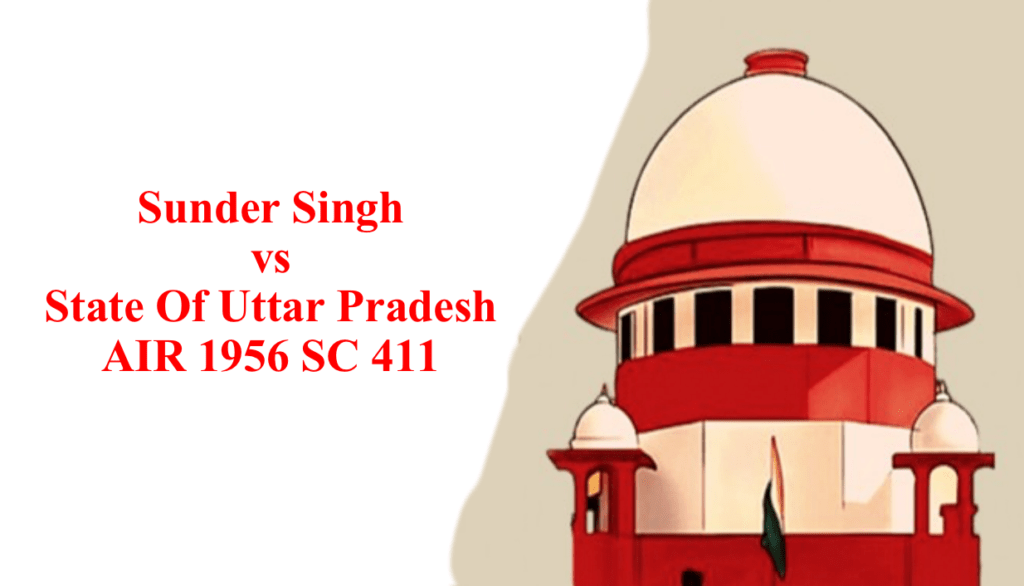
Sunder Singh vs State Of Uttar Pradesh AIR 1956 SC 411
Introduction
In Indian criminal law, the landmark case Sunder Singh v. State of Uttar Pradesh AIR 1956 SC 411 was decided. The principles of circumstantial evidence and the burden of proof in criminal cases drive the case.
The case began when Sunder Singh was accused of killing his mother-in-law and wife. Because there were no witnesses to the crime, the prosecution relied solely on circumstantial evidence to support its case. Sunder Singh was found guilty and given the death penalty by the trial court.
The Allahabad High Court granted Sunder Singh’s appeal and upheld his conviction and sentence. After that, he made an appeal to India’s Supreme Court.
The Supreme Court’s primary concern was determining whether the circumstantial evidence was sufficient to support the conviction. The prosecution’s case had some holes and missing links, according to the court’s review of the evidence. The court noted that while some of the circumstances supported the accused’s guilt, others were inconsistent with the prosecution’s case.
The court decided that in a case based on circumstantial evidence, the circumstances must be so strong and convincing that it is impossible to avoid coming to the conclusion that the accused person was the one who committed the crime. The court likewise stressed that the obligation to prove any claims in a lawbreaker case generally lays on the indictment, and the blamed is assumed free of guilt by default for certain.
The Supreme Court acquitted Sunder Singh of all charges and overturned his conviction and sentence based on these principles. The case is significant because it emphasized the significance of the prosecution meeting the high standard of proof that is required in criminal cases based on circumstantial evidence.
Background of the case
The foundation of the instance of Separate Singh versus Province Of Uttar Pradesh AIR 1956 SC 411 traces all the way back to the year 1953 when a horrifying twofold homicide occurred in the town of Saharanpur in the territory of Uttar Pradesh, India. Sunder Singh’s wife and mother-in-law were the victims.
One of the deceased’s husband and the other’s son-in-law, Sunder Singh, were both suspected of the murders. Sunder Singh was detained by the police after an investigation, and he was later charged with the murders.
The preliminary started in the court of the Extra Meetings Judge, Saharanpur. Since there were no witnesses to the crime, the prosecution relied on circumstantial evidence to support its case. The arraignment contended that the rationale behind the killings was the stressed connection between Divide Singh and his significant other, which had been falling apart for quite a while.
The guard, then again, contended that there was no immediate proof against Divide Singh and that the arraignment’s case depended on guess and doubt. The prosecution had not been able to prove Sunder Singh’s guilt beyond a reasonable doubt, according to the defense, and there were other people who were motivated to commit the murders.
The trial court found Sunder Singh guilty and handed him the death penalty after hearing both sides. Divide Singh engaged the Allahabad High Court, yet his allure was excused. After that, he took his case to the Supreme Court of India, which eventually found him not guilty of any charges.
Pre- case Years
Sunder Singh was married and lived in Saharanpur, Uttar Pradesh, with his wife and mother-in-law. It can likewise be expected that he was an occupant of the town or the encompassing region.
Sunder Singh’s past criminal record and any other significant life events prior to the incident were unknown. The case itself does not provide any information about his prior professional or personal life.
It is critical to take note of that the case essentially rotates around the proof introduced at the preliminary and the lawful standards applied by the courts in arriving at their choice. As a result, Sunder Singh’s prior personal life has no direct bearing on the current legal issues.
Legal Questions raised in the case
The Sunder Singh v. State of Uttar Pradesh AIR 1956 SC 411 case brought up a number of significant legal issues, including:
- In a criminal case that is based on circumstantial evidence, what is the standard of proof that must be met?
- In a criminal case, who is responsible for proving the case beyond a reasonable doubt and what is the burden of proof?
- Might a conviction at any point be founded exclusively on incidental proof, or is there a prerequisite for some immediate proof too?
- When evaluating the evidence presented by the prosecution and the defense, what role does the court play?
- How might the court assess clashing or conflicting proof in a crook case?
- In the prosecution’s case, what legal significance do gaps or missing links have, and how do they affect the strength of the evidence as a whole?
The Supreme Court provided guidance on how to apply the law in cases based on circumstantial evidence and addressed these legal issues. The court underlined the significance of the arraignment fulfilling the high guideline of verification expected in criminal cases and the requirement for the proof to areas of strength for be sufficiently fitting to prompt the overwhelming end that the denounced and no other person was the culprit of the wrongdoing. Additionally, the court reiterated that the prosecution always bears the burden of proof and that the accused is presumed innocent until proven guilty beyond a reasonable doubt.
The Arguments Raised by the Parties
The prosecution and defense presented distinct arguments to the court in Sunder Singh v. State of Uttar Pradesh, AIR 1956 SC 411.
The prosecution argued that Sunder Singh’s strained relationship with his wife and mother-in-law provided a motivation for the murders. Sunder Singh’s inability to provide a satisfactory explanation for his movements on the night of the murders, as well as his inconsistent statements to the police, were examples of circumstantial evidence presented by the prosecution to support their case.
In contrast, the defense argued that the prosecution’s case was based solely on conjecture and suspicion and that there was no direct evidence linking Sunder Singh to the crime. The prosecution had not been able to prove Sunder Singh’s guilt beyond a reasonable doubt, according to the defense, and there were other people who were motivated to commit the murders.
In addition, the defense questioned the admissibility and reliability of the circumstantial evidence presented by the prosecution and argued that the prosecution’s case was weaker overall due to gaps and missing links.
In the end, the court had to look at the evidence from both sides and use criminal law principles to make a decision. Sunder Singh was ultimately cleared of all charges by the court because the prosecution’s evidence was insufficient to support a conviction beyond a reasonable doubt.
Post-Case Years and Development
Sunder Singh was cleared of all charges by the Supreme Court, and no further legal action was taken against him in connection with the murders.
However, courts in subsequent cases involving circumstantial evidence referred to the case as a landmark decision in Indian criminal law.
The judgment for the situation likewise featured the requirement for solid and relevant proof to support a conviction in a crook case and the significance of the indictment satisfying the high guideline of confirmation expected in such cases.
The principles established in the case have been reaffirmed and further developed by Indian courts in subsequent rulings, forming the country’s jurisprudence on circumstantial evidence.
The Sunder Singh v. State of Uttar Pradesh AIR 1956 SC 411 case is still regarded as a significant turning point in Indian criminal law and a demonstration of the significance of the rule of law and the administration of justice in a fair manner.
Conclusion
In conclusion, the landmark Indian criminal law decision Sunder Singh v. State of Uttar Pradesh AIR 1956 SC 411 addressed significant legal issues pertaining to circumstantial evidence, the burden of proof, and the standard of proof in criminal cases.
The case emphasized how important it is for the prosecution to meet the high standard of proof required in criminal cases and how important it is for the evidence to be strong and convincing enough to convince the jury that the accused person was the one who committed the crime.
In subsequent cases involving circumstantial evidence, courts have cited and relied on the case’s judgment, which has shaped India’s criminal law jurisprudence.
In general, the Sunder Singh v. State of Uttar Pradesh AIR 1956 SC 411 case is still regarded as a significant turning point in Indian criminal law and a demonstration of the significance of the rule of law and the administration of justice in a fair manner.
Written by Roli Nayan (8th sem BA LLB) student of REVA University, Bangalore


![SEPCO Electric Power Construction Corporation Vs. Power Mech Projects Ltd. [August2021]](https://legalvidhiya.com/wp-content/uploads/2025/01/image-63-360x240.png)
![Union of India Vs. Association of Unified Telecom Service Providers of India [July 23, 2021]](https://legalvidhiya.com/wp-content/uploads/2025/01/image-62-360x240.png)
0 Comments